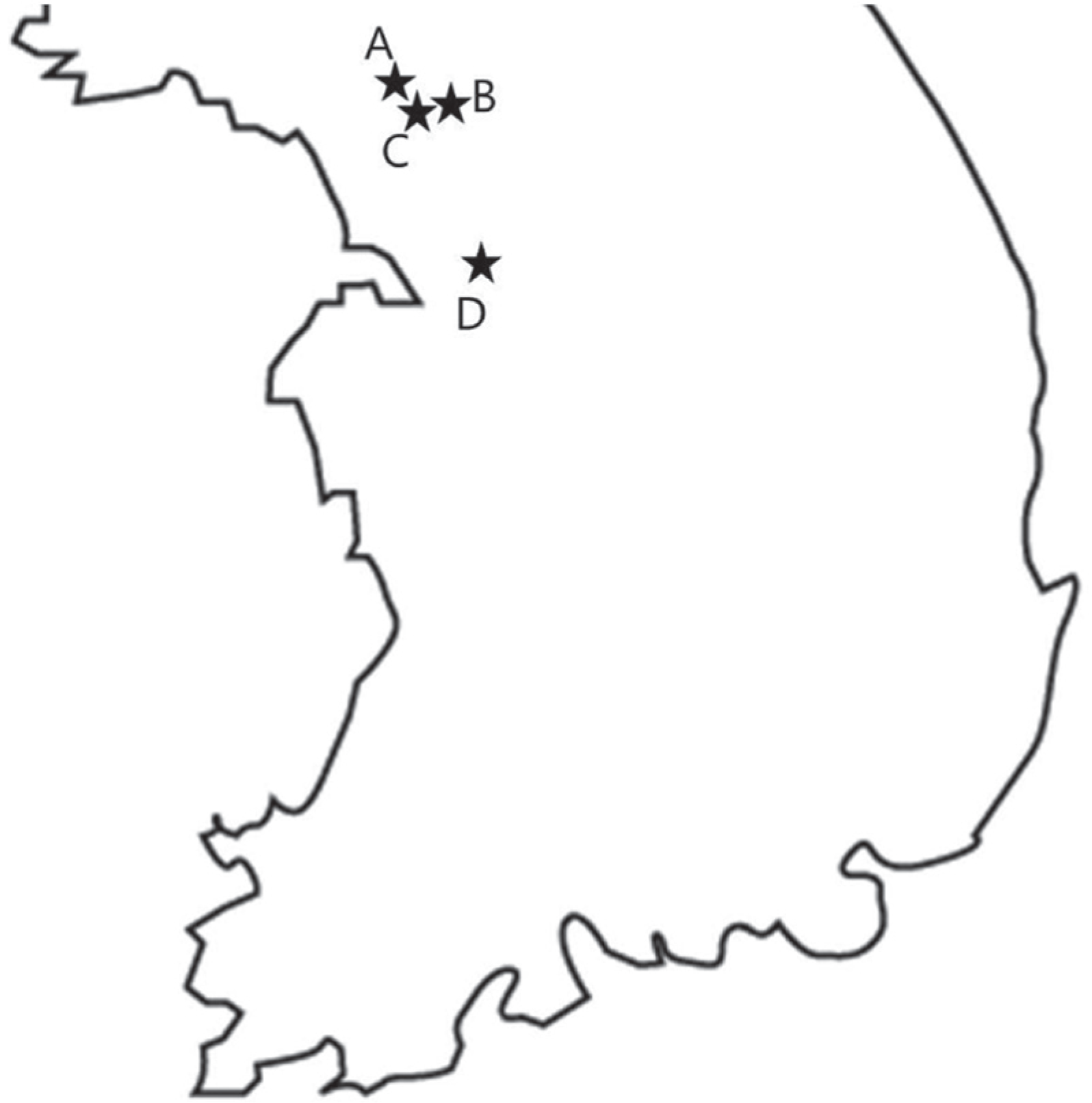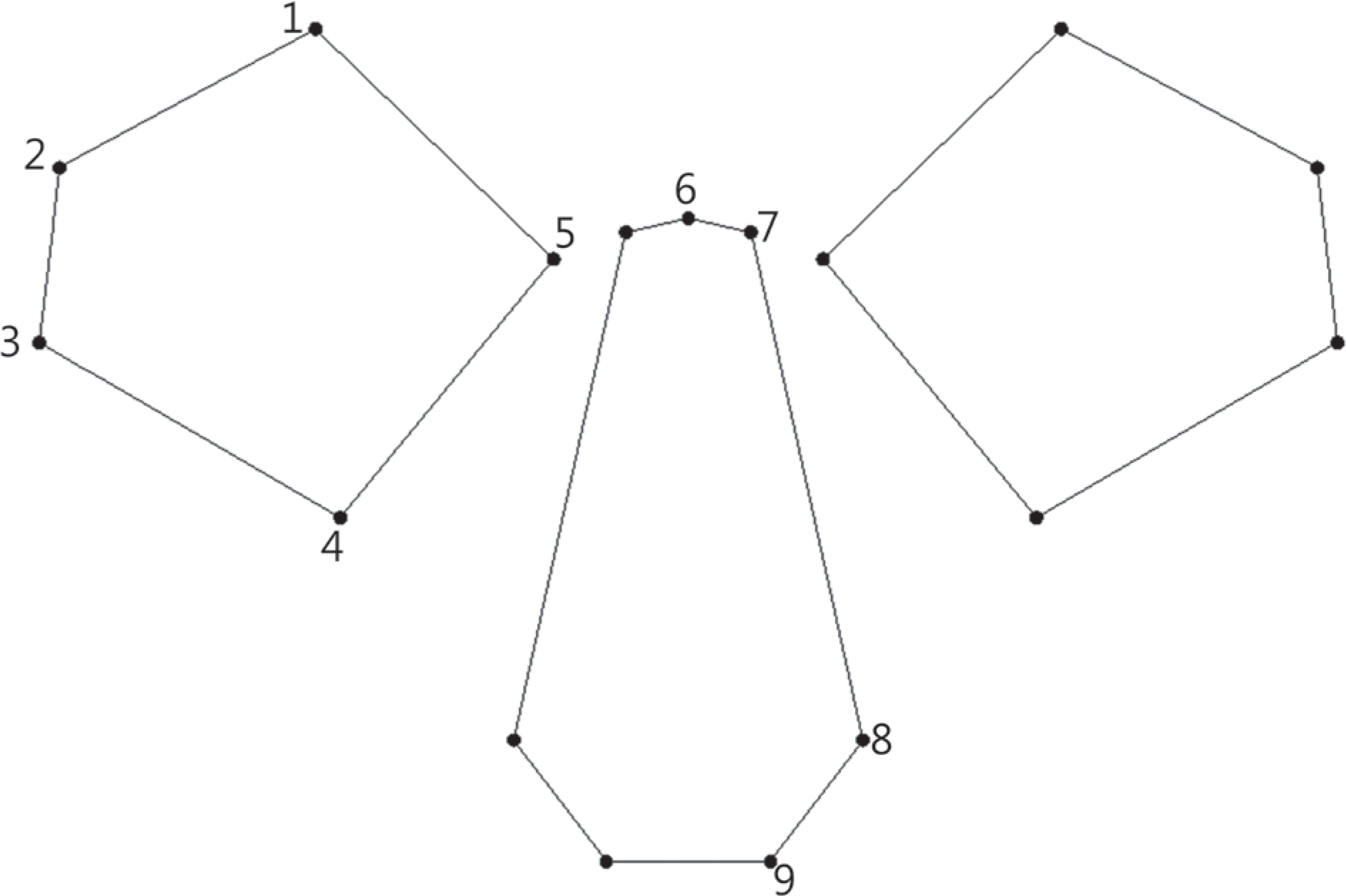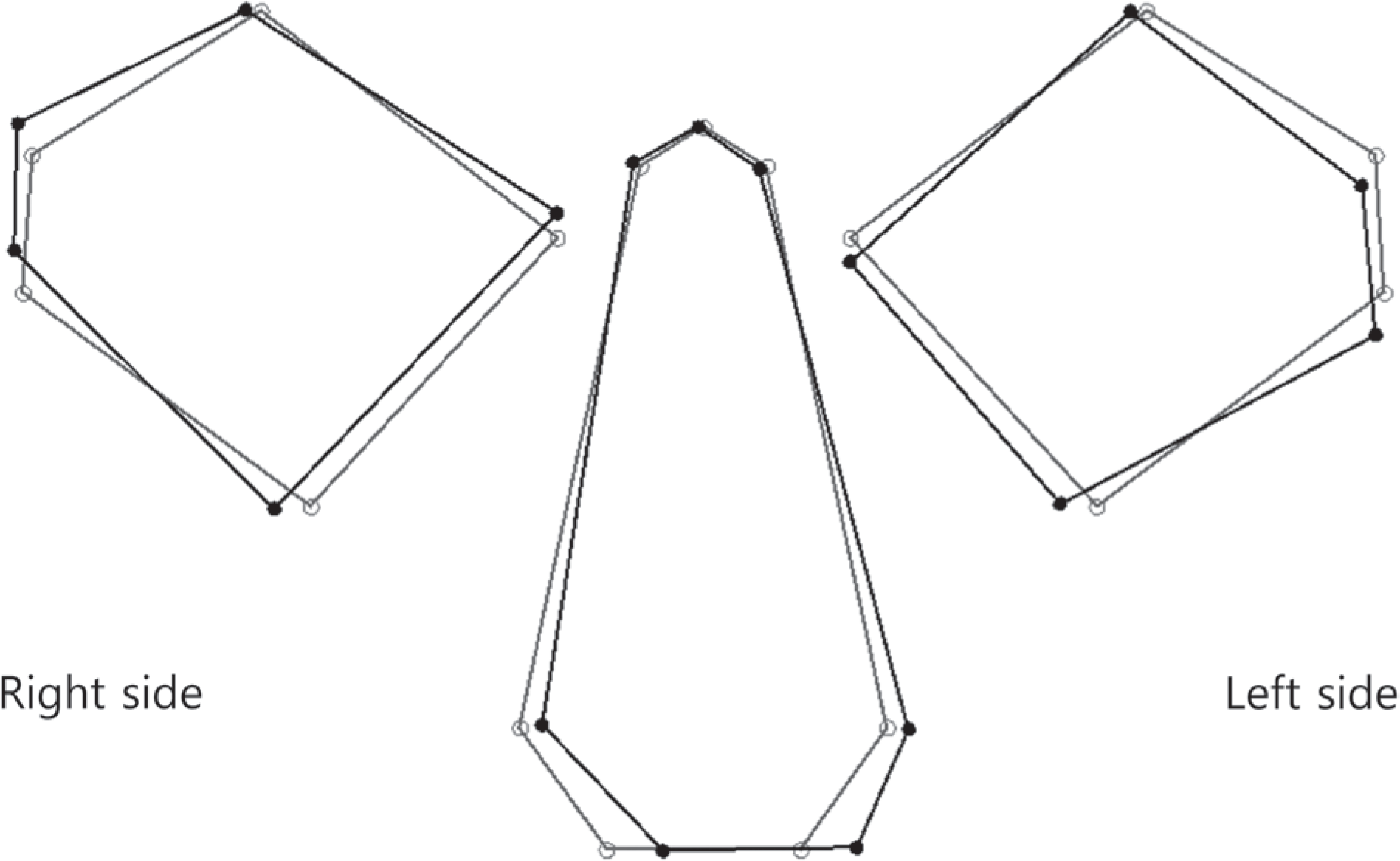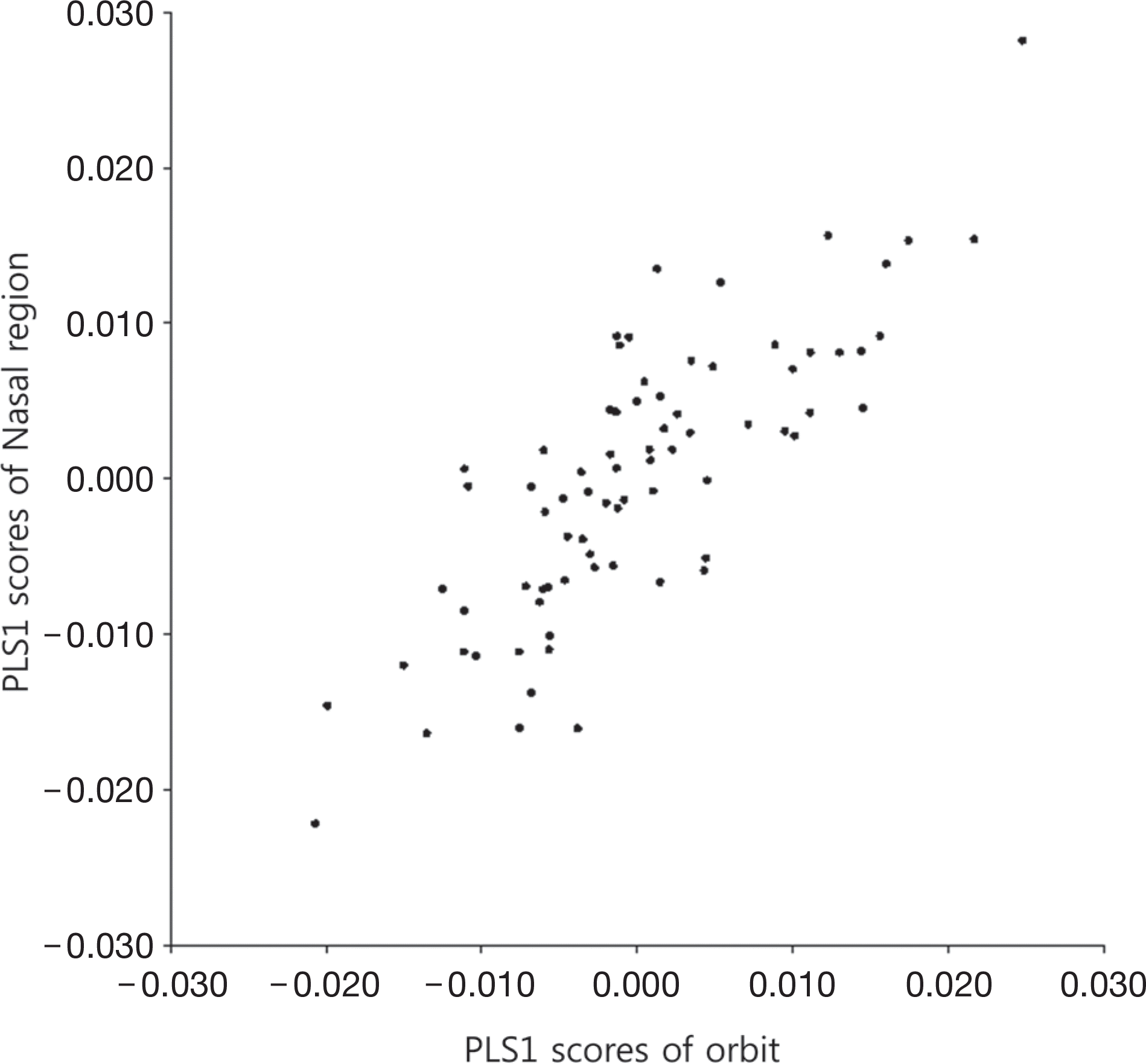Abstract
In this study, the pattern of bilateral asymmetry in the eye orbit and nose of the Joseon Dynasty skeletal group was analyzed using geometric morphometrics. For this, 38 adult males and 38 adult females from the Joseon Dynasty skeletal group belonging to the 15th to early 20th centuries were examined. For geometric morphometric analysis, Procrustes superimposition was performed on 10 landmarks in both eye orbits and 7 nasal landmarks. The data were analyzed by multivariate analysis of variance with partial least square scores.
In results, the lateral landmarks had more impact on the bilateral asymmetry in the eye orbit and nose than the center landmarks. The eye orbit and nose on the right side of the face seemed bigger than those of the left side, while the direction of asymmetry in the eye orbit and nose was different. The correlation between asymmetry patterns in the eye orbit and nose were statistically significant (p<0.01). The results of this study will be useful for examining causes of bilateral asymmetry in the eye orbits and noses of the Korean population.
Go to : 
References
1. Takenake M. Morphological traits of crania in modern Kyongsangnam-do Koreans. Acta Anat Nippon. 1994; 69:645–60.
2. Koh KS, Hwang YI, Shon HJ, Han SH, Paik DJ, Kim HJ, et al. Reevaluation of the orbital dimensions in modern Korean adult skulls. Korean J Phys Anthropol. 1995; 8:195–204. Korean.

3. Han SH, Hwang YI, LEE KH, Koh KS, Choi BY, Lee KS, et al. Craniometric study in modern Korean adult. Korean J Phys Anthropol. 1995; 8:205–13. Korean.
4. Koh KS, Shon HJ, Rhee EK, Park SJ, Kim HJ, Han SH, et al. Anthropological study on the facial flatness of Korean from the historic to the modern period. Korean J Phys Anthropol. 1999; 12:211–21. Korean.

5. Lieberman DE. The evolution of the human head. Cambridge: The Belknap Press of Harvard University Press;2012.
6. von Cramon-Taubadel N. Evolutionary insights into global patterns of human cranial diversity: population history, climatic and dietary effects. J Anthropol Sci. 2014; 92:43–77.
7. Woo TL, Morant GM. A biometric study of the “flatness” of the facial skeleton in man. Biometrika. 1934; 26:196–250.

8. Krogman WM, Iscan MY. The human skeleton in forensic medicine. Illinois: Charles Tomas Publisher;1986.
9. Steegmann AR. A study of relationships between facial cold response and some variables of facial morphology. Am J Phys Anthropol. 1965; 23:355–62.

10. Paschetta C, de Azevedo S, Castillo L, Martínez-Abadías N, Hernández M, Lieberman DE, et al. The influence of masticatory loading on craniofacial morphology: a test case across technological transitions in the Ohio valley. Am J Phys Anthropol. 2010; 141:297–314.

11. Novack ML, Harvati K, Spoor F. Climate-related variation of the human nasal cavity. Am J Phys Anthropol. 2011; 145:599–614.
12. Quinto-Sanchez M, Adhikari K, Acuna-Alonzo V, Cintas C, de Cerqueira CCS, Ramallo V, et al. Facial Asymmetry and Genetic Ancestry in Latin American Admixed Populations. Am J Phys Anthropol. 2015; 157:58–70.
13. Bigoni L, Krajíček V, Sládek V, Velemínský P, Velemínská J. Skull shape asymmetry and the socioeconomic structure of an early Medieval central European society. Am J Phys Anthropol. 2013; 150:349–64.

14. Gangestad SW, Thornhill R, Yeo RA. Facial Attractiveness, Developmental Stability, and Fluctuating Asymmetry. Ethol Sociobiol. 1994; 15:73–85.

15. Swaddle JP, Cuthill IC. Asymmetry and human facial attractiveness: symmetry may not always be beautiful. Proc R Soc Lond B. 1995; 261:111–6.
16. Kim YS, Chung MS, Park DK, Song WC, Koh KS. Asymmetric study on the Korean skull using bilateral measurements. Korean J Phys Anthropol. 2000; 13:271–9. Korean.

17. von Cramon-Taubadel N, Frazier BC, Lahr MM. The Problem of Assessing Landmark Error in Geometric Morphometrics: Theory, Methods, and Modifications. Am J Phys Anthropol. 2007; 134:24–35.

18. Central Institute of Cultural Heritage. A report on the excavation of Jingwan-dong, Eunpyeong-gu, Seoul;. 2009. Korean.
19. Gyeonggi Cultural Properties Institute. A report on the excavation of Manjeong-ri, Anseong;. 2009. Korean.
20. Institute of Korean Prehistory. A report on the excavation of Unjeong site, Paju;. 2012. Korean.
21. Institute of Korean Prehistory. A report on the excavation of Sinwon-dong·Wonheung-dong site, Goyang;. 2011. Korean.
22. Richtsmeier JT, Deleon VB, Lele SR. The promise of geometric morphometrics. Yearb Phys Anthropol. 2002; 45:63–91.

24. Zelditch ML, Swiderske DL, Sheets HD. Geometric mor-phometrics for biologists: a primer, 2nd ed. Oxford: Elsevier Academic Press;2012.
25. von Cramon-Taubadel N. The relative efficacy of functional and developmental cranial modules for reconstructing global human population history. Am J Phys Anthropol. 2011; 146:83–98.

26. Van Valen L. A study of fluctuating asymmetry. Evolution. 1962; 16:125–42.
27. Good P. Permutation tests: a practical guide to resampling methods for testing hypotheses. New York: Springer;2000.
28. Klingenberg CP. MorphoJ: an integrated software package for geometric morphometrics. Mol Ecol Resour. 2011; 11:353–7.

29. Rossi M, Ribeiro E, Smith R. Craniofacial asymmetry in development: an anatomical study. Angle Orthod. 2003; 73:381–5.
30. Hartman C, Holton N, Miller S, Yokley T, Marshall S, Srinivasan S, et al. Nasal septal deviation and facial skeletal asymmetries. Anat Rec. 2016; 299:295–306.

31. Ruff CB, Holt B, Trinkaus E. Who's afraid of the big bad Wolff?: “Wolff's Law” and bone functional adaptation. Am J Phys Anthropol. 2006; 129:484–98.

32. Ingervall B, Helkimo E. Masticatory muscle force and facial morphology in man. Arch Oral Biol. 1978; 23:203–6.

33. Raadsheer MC, Kiliaridis S, Van Eijden TMGJ, Van Ginkel FC, Prahl-Andersen B. Masseter muscle thickness in growing individuals and its relation to facial morphology. Arch Oral Biol. 1996; 41:323–32.

34. Moreira RS, Sgrott EA, Stuker H, Alonso LG, Smith RL. Palatal asymmetry during development: an anatomical study. Clin Anat. 2008; 21:398–404.

35. Gomes SGF, Custodio W, Faot F, Cury AADB, Garcia RCMR. Chewing side, bite force symmetry, and occlusal contact area of subjects with different facial vertical patterns. Braz Oral Res. 2011; 25:446–52.

36. Nissan J, Gross MD, Shifman A, Tzadok L, Assif D. Chewing side preference as a type of hemispheric laterality. J Oral Rehabil. 2004; 31:412–6.

37. Martinez-Gomis J, Lujan-Climent M, Palau S, Bizar J, Salsench J, Peraire M. Relationship between chewing side preference and handedness and lateral asymmetry of peripheral factors. Arch Oral Biol. 2009; 54:101–7.

39. Shah SM, Joshi MR. An assessment of asymmetry in the normal craniofacial complex. Angle Orthod. 1978; 48:141–8.
40. Good CD, Johnsrude I, Ashburner J, Henson RNA, Friston KJ, Frackowiak RSJ. Cerebral asymmetry and the effects of sex and handedness on brain structure: a voxel-based morphometric analysis of 465 normal adult human brains. Neuro Image. 2001; 14:685–700.

41. Balzeau A, Gilissen E, Grimaud-Hervé D. Shared pattern of endocranial shape asymmetries among great apes, anatomically modern humans, and fossil Hominins. PlosOne. 2012; 7:e29581.

42. Enlow DH, Hans MG. Essentials of facial growth. Philadelphia: Saunders Company;1996.
Go to : 
 | Fig. 1.Location of skeletal groups in this study. A: Goyang; B: Eunpyeong; C: Paju; D: Anseong. |
 | Fig. 2.Landmarks used in this study. 1: supraconchion; 2: fron-tomalareorbitale; 3: ectoconchion; 4: zygoorbitale; 5: dacryon; 6: nasion; 7: infranasion; 8: alare; 9: nariale. |




 PDF
PDF ePub
ePub Citation
Citation Print
Print




 XML Download
XML Download